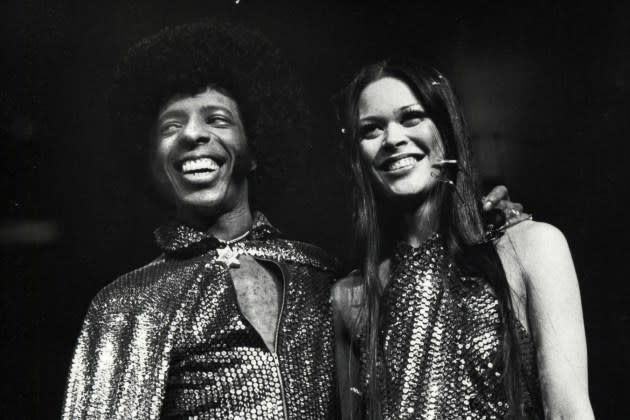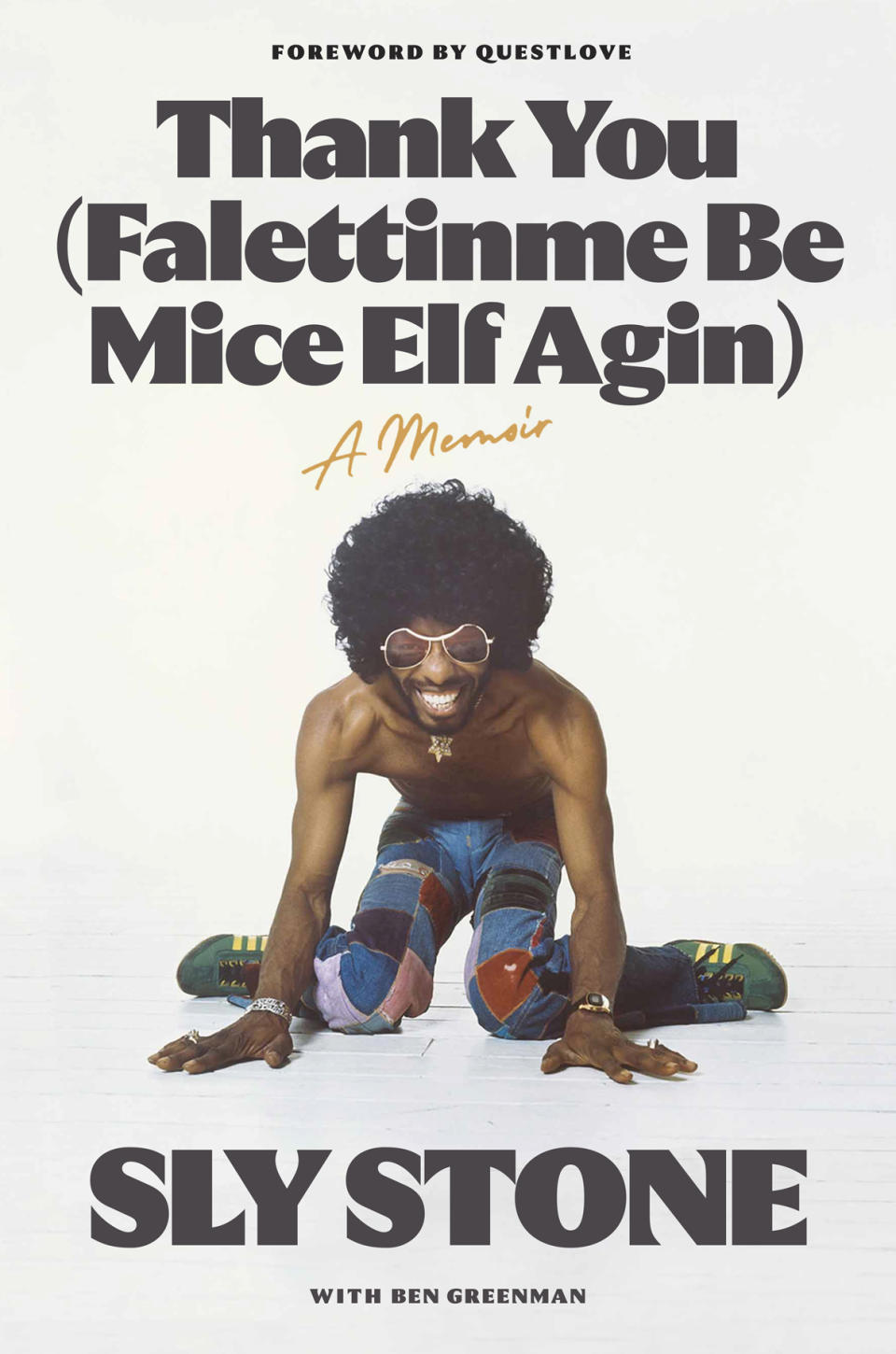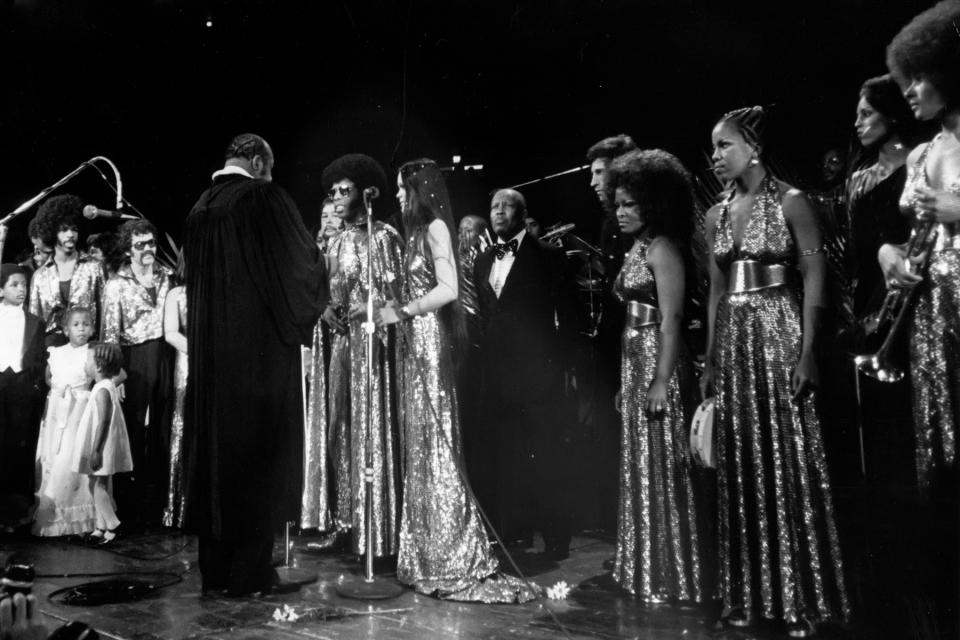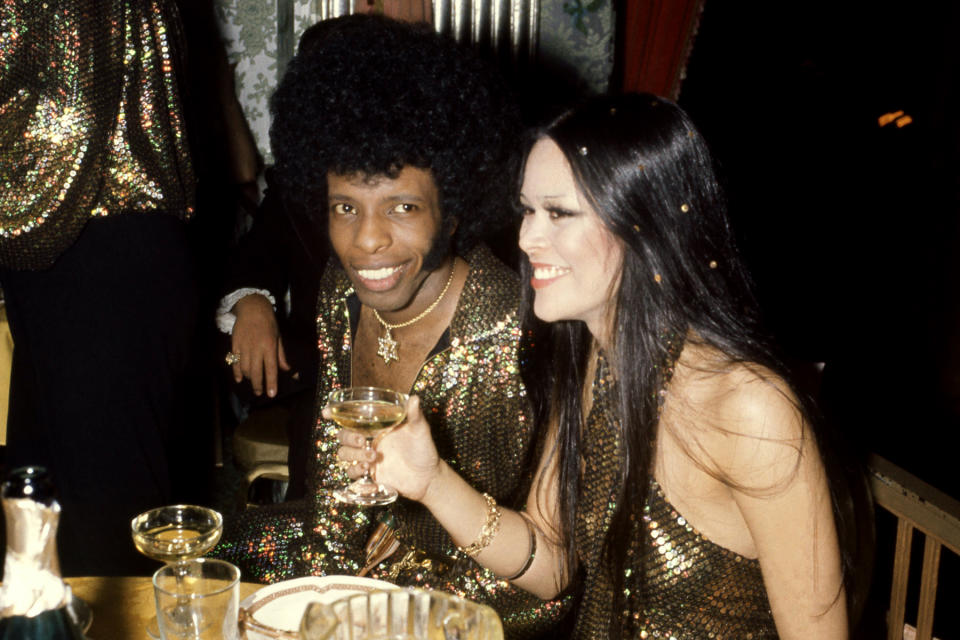That Time Sly Stone Got Married at Madison Square Garden

In the Sixties and Seventies, Sly Stone and his band invented an undeniable cocktail of pop, soul, and psychedelia on hits like “Dance to the Music,” “Hot Fun in the Summertime,” “Family Affair,” and more. But Stone also grappled with drug addiction for decades, which is clear from the first sentence of his upcoming memoir: “I decided to get clean on the fourth visit.”
Co-written with Ben Greenman, who has also worked with Questlove on his books, Thank You (Falettinme Be Mice Elf Agin) (AUWA Books, Oct. 17) traces Stone’s life from his childhood in Northern California and his early days as a DJ (where Sylvester Stewart became Sly Stone) to the formation of his band, Sly and the Family Stone, and the making of hits like “Everyday People” (he played the piano so hard he broke his finger) and albums like 1971’s post-Sixties-buzzkill There’s a Riot Goin’ On. Stone also chronicles the band’s euphoric appearance at Woodstock, one of the highlights of the documentary made of the festival, and his years hobbled by cocaine and other drugs.
More from Rolling Stone
In 1974, during what he calls “big years, star years,” Stone had a true pop-culture moment when he and his girlfriend Kathy Silva were married — not in a church but at Madison Square Garden. The two had recently given birth to a child, Sylvester Stewart Jr. Although it wasn’t televised, the wedding, which was followed by a full concert by his band, paved the way for reality TV in the way that it merged public and personal lives. It would also mark a moment before a steep decline: The album he released that year, Small Talk, would be his last to make the Top 20, Sly and the Famly Stone would break up a year later, and he and Silva eventually divorced. In this excerpt, Stone writes about the planning for that surreal day.
###
I was sitting on a couch, watching TV and thinking on my situation with Kathy and Sylvester Jr. Getting married still seemed like the thing to do, and more and more it seemed like the thing to do soon. I called Steve Paley.
He answered and I proposed — not to him, but I proposed the plan. “A wedding?” he said. The idea filled the line. “Where are you thinking of doing it?” I said Hawaii, where Kathy was from. Then I said New York. I liked the city. I liked walking around. I loved sushi. I had my place at the Century. Either me or Steve said that it should happen at Madison Square Garden and the other one laughed. But the seed had been planted.
The next day I called Steve back. He wasn’t there so his answering machine picked up. “This is Sly,” I said, “and I need you to help me make this wedding the year’s biggest deal.” I told the machine to tell Steve to call me back. I may have even knocked out a rhythm on the rim of the receiver and said “What time is it?” I did that to Steve sometimes. I didn’t want him to say noon or two thirty. I wanted him to say 3/4 or 4/4 or 7/8. He liked watching me listen to other people’s music. He said I nodded in strange rhythms that were like previews of songs I’d soon be making.
He called me back later that day, and we grew the idea from a seed to a bud, from a bud to a flower. I could do a gig, get paid, and get married at the same time. “Go, go, go,” I told him. He went and went fast. We set the date for June 5, a Wednesday. We’d have a ceremony just before the concert, right there on the stage. Then a concert, then a party afterward at the rooftop lounge of the Waldorf Astoria. Steve wanted everyone to wear gold to keep the shine high. Invitations went out:
You are invited to a golden affair, the wedding of Kathy Silva
and
Sly Stone
at Madison Square Garden
on Wednesday night the fifth of June, followed by the concert of
Sly and the Family Stone.
And to the reception immediately following at the Starlight Roof of the Waldorf Astoria, 49th Street at Park Avenue.
Kindly respond by Friday, May 31, 1974. Wear something gold.

I asked Steve to be my best man. I knew he would make the event easier, and figured he’d make it easiest if he was in it. Later I found out that Freddie wasn’t sure why I didn’t pick him. If Freddie had talked to me about it, I would have switched over. It was not a slight, just a sense of how Steve could help.
People held meetings. Meetings were held by people. I was unable to attend due to concert commitments (all of which I kept). Much of those meetings, I was told, involved ironing out details for the reception. What kind of food would be served? What kind of champagne would be poured? What kind of cake would be cut? Japanese and soul food, to pay off the Hawaiian bride and black groom. New York champagne, to pay off the city. A round cake with a gold record on top, to pay off the business I was in.
People made calls. Calls were made by people. I was not on the phone. Money was an issue — the boat needed to keep floating in the lead-up to the wedding — so Ken Roberts called in the rest of the advance for the new album, Small Talk, which was coming out in the summer. Or maybe Ken called Steve and Steve called the Record Plant and the tapes were released to Epic in exchange for a big check. The boat floated.
People hired designers. Designers were hired by people. I did not participate in the hiring. Steve took care of it, along with a guy named Joe Eula. Joe worked with Halston, the celebrity fashion designer, who had agreed to make clothes for everyone: me, Kathy, my parents, the entire wedding party. Steve and Joe started thinking of ideas to make everything bigger. Some of them were communicated to me: something about doves released to fly around stage, something else about the wedding party marching down the Garden’s main aisle.
Steve and Joe and the others made decisions. In some cases, decisions were made for them. The ASPCA wouldn’t allow the doves. The wedding party couldn’t march down the aisle without extra security, and extra security carried an extra cost. Improvisations followed. Steve found an artist to make projections that would take the place of the doves. The march down the aisle got scrapped.
When I got back from touring, I was told that I would be expected the following morning at Halston’s studio for a fitting. Kathy and the bridesmaids had been already, more than once.
Steve and my friend Buddha, who worked as a kind of assistant, came up to escort me down. There was an article written about the wedding back then in The New Yorker, and even though I don’t remember the reporter coming upstairs, he must have, because he got a good look at my apartment. He noticed the colors of the place (red, white, and black, like my redesigned American flag), the big stereo Epic had given me. He even wrote down the names of the magazines on my coffee table: Fred Russell’s Car Care, Gambling Quarterly, Texas Football, Basic Automotive Tools & How to Use Them, Popular Imported Cars, Action Black Belt. No New Yorker. Some of them I still remember. I used Basic Automotive Tools to work on my cars or think about working on them. I used Gambling Quarterly mostly to satisfy my curiosity about poker or sports or horses. I got Action Black Belt because I was still learning karate, not just with Teru but at a kempo school in Los Angeles.
“Let’s go,” Steve said, tapping a watch. Time for Halston. But I couldn’t just go over there in the first clothes of the day. I changed into a beige cowboy suit studded with red stones. It was a Nudie original. Nudie was a Russian Jewish designer who had a shop in North Hollywood, big with musicians (he made the gold suit Elvis wore on the cover of 50,000,000 Elvis Fans Can’t Be Wrong). He loved cars almost as much as I did. Did Halston know who Nudie was? I also had diamond pinkie rings that spelled out my name, first name on the right hand, last name on the left, and a bracelet that spelled out both first and last.
At Halston’s place, a secretary brought us into a room of mirrors. Halston was in most of them, thin, dark hair, turtleneck. He didn’t mention the Nudie suit, but he told me about what the bridesmaids would be wearing, and what he thought about those outfits. Then he sat at a desk while his assistants took my measurements. They had to do it all over again when an NBC crew showed up to help promote the concert.
The concert? Of course: the wedding was also a concert. A concert needed music and a wedding needed special music. I tried to get a recording down of a wedding march in the band’s style, in my style. That meant lots of calls to Steve to help arrange a session of some kind. I asked for someone to come out to my house to record me there, which would have been better than nothing, but nothing doing. I got him to schedule time for me with John Hammond at Columbia, but I never made it there. The march fell apart but everything else was falling into place: people’s hair and makeup and final fittings, rings for the ceremony to come, introductions between people who needed to be introduced. I took a car to the Garden and had a few minutes to rehearse some of our new songs.

And then it was show time. It had happened hundreds of times before, in little clubs in New York City, in front of a huge crowd at Woodstock. But it had never happened on a night when I was getting married. We had twenty thousand guests at least, with some of the estimates as high as twenty-five. Years later I saw a picture of a ticket someone kept: $8.50 for a wedding and a concert both. A bargain.
Eddie Kendricks opened for us, and then my mother came out to start things off. Her main point, expressed on the microphone, was that a wedding was a holy moment that should not blend so easily into the rest of the night’s entertainment. My niece Lisa reminded everyone again by coming out and singing a spiritual, the same way I used to sing in Vallejo: “I don’t worry about tomorrow for I know what my Jesus says.”
Faith went out and fashion came in. Models appeared, carrying the gold palm leaves. Then Kathy came out. I had seen the dress in Halston’s place but I had not seen her in the dress. Then it was me, sunglasses to block the glint from all the gold. Bishop B. R. Stewart (no relation), flown in from San Francisco, described the evening’s purpose: “We are gathered together here tonight in the sight of God and in the face of this company to join together this man and this woman in holy matrimony. Sly, would you repeat these words after me? Don’t be nervous.” I laughed, but I was, a little. When it was Kathy’s turn, Bishop Stewart, adjusting the microphone for her, accidentally called her “Cynthia.” A slip of the lip can sink a ship, but we went on. She reaffirmed the vows. As Bishop Stewart, with the power vested in him, got ready to pronounce us man and wife, he doubled up my name, “Sly Stone Sylvester Stewart,” like he was afraid to leave anyone out. But this time he called Kathy Kathy. And then we were married. The crowd screamed. It didn’t change much except in the eyes of the world, and the eyes of the world were on us.

The reception at the Waldorf had lines down the block of people trying to get in. A few were me, or people who claimed to be me, dressed up to pass, like I wouldn’t have been inside already at my own wedding reception. A few claimed to be Sammy Davis Jr., too. The party was drinking and dancing and smoking and joking, until the late hours and then the early hours, the kind of thing you remember only from the pictures you see afterward.
The next day there was more news. Bishop Stewart wasn’t registered in New York. He had to go down to the city clerk and ask to have his paperwork put through so that he could be official and our marriage could be counted. He did. He was. It was.
The story was perfect for magazines. In June, a new magazine named People Weekly covered the wedding by putting my name on the cover, even though I didn’t get the photo — it was Henry Kissinger and his wife Nancy, also newlyweds.
Best of Rolling Stone

